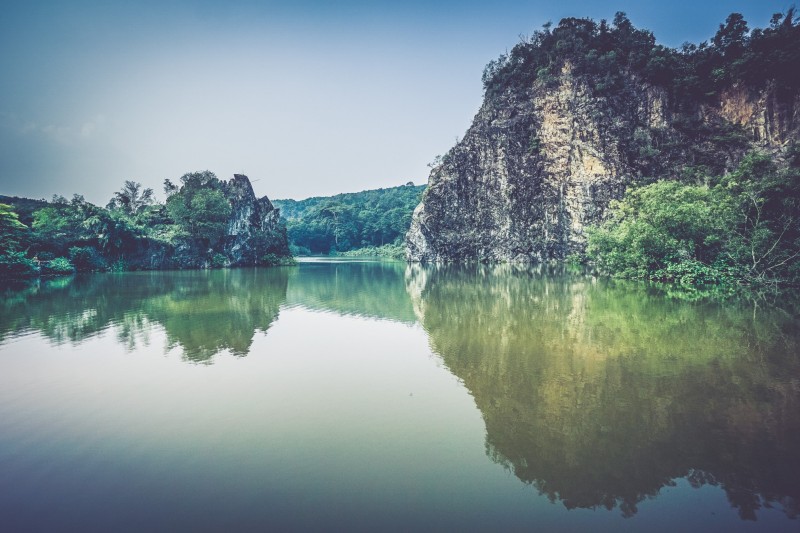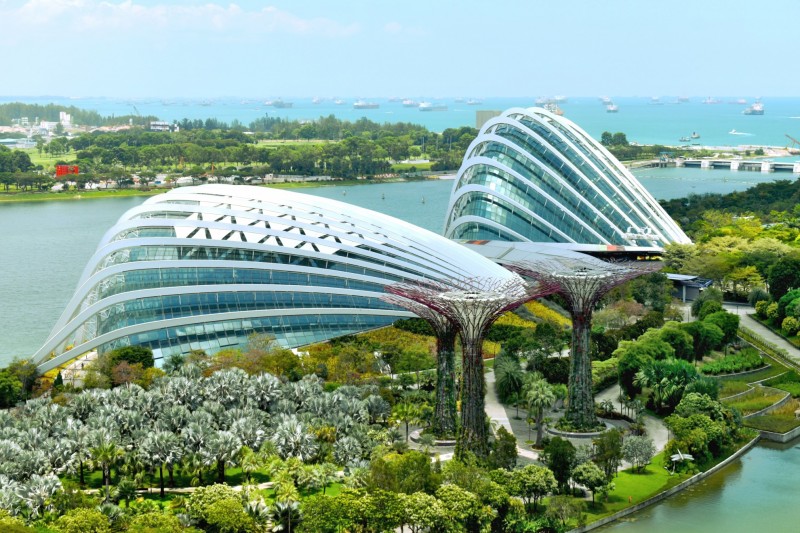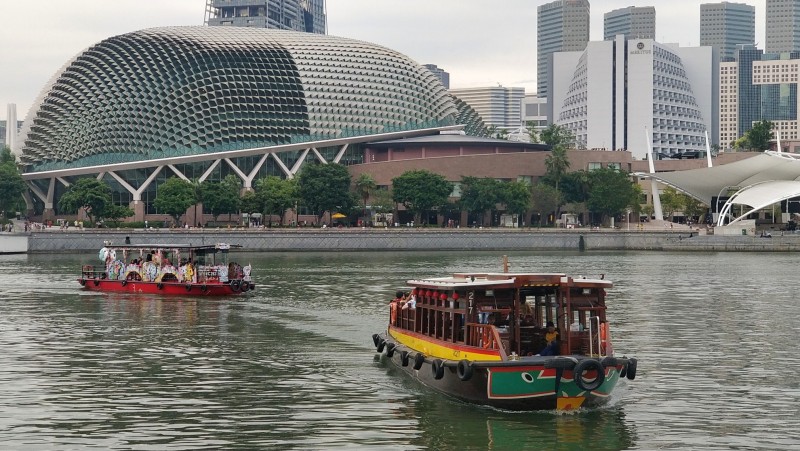Singapore
Singapore
Capital city description
Singapore is the capital of Singapore. A microstate, Singapore is both a city and a country. Singapore is only 276 square miles or 697 square kilometers. All of the country's governmental institutions are located in Singapore. It is home to some of Asia's best museums. More than 7,000 drawings, prints, paintings, sculptures, and photographs are on display at the Singapore Art Museum, and the National Museum showcases some of the country's greatest treasures.
Climate
The climate in Singapore is hot, humid, and rainy throughout the year. Although the climate is relatively similar, there are some variations in the course of the year due to the two monsoons: the north-east monsoon, which occurs from November to early March and is rainier, especially in the first part, and the south-west monsoon, which arises from June to September. The first period between the two monsoons, from March to early June, is the hottest and the most unpleasant of the year.
Languages spoken
Singapore’s four official languages are Malay, Mandarin, Tamil, and English. Almost everyone speaks English, which is the business and administrative language. Most of the school curriculum is also in English, which was selected as a national language partly to unify Singapore's different ethnic groups.
Fun/Fascinating Facts
- Singapore has the world’s tallest indoor waterfall, which is 35 meters high! It’s in The Cloud Forest conservatory in Gardens by the Bay.
- n Singapore, Chewing Gum is currently banned except without medical prescription.
- Singapore’s national anthem is in micro-text on the back of their $1,000 note.
- Elevators in Singapore have Urine Detection Device, and if it detects the smell of kidney-filtered water, it locks the doors until the police arrive. Singapore has passed a particular law that prohibits urinating in elevators.
- There is an actual law against not flushing the public toilet after using it in Singapore, and you will be fined SGD 150 if you get caught.
Unique Customs/Traditions
In Singapore, the elderly, especially those with a Chinese background, are addressed as uncle or auntie – even if there's no relationship.
Traditionally, Singaporeans don't wear shoes in the house, so take off your footwear before coming in. Remember to take off your shoes before entering any temple or mosque!
When Singaporean Muslims visit mosques, all the neighboring areas are quiet - everybody understands: it's their time for prayer.
When you give a gift, you should hold it with both hands. Souvenirs are usually packed in red or yellow paper. According to local belief, these shades bring luck. Red is one of the symbols of the country.
Local people eat with bamboo sticks, while a set of cutlery customary for the inhabitants of the western hemisphere is always present. Regardless of what type of cutlery a Singaporean prefers, they always use only the right hand. This custom comes from the religious tradition of the Malays, who consider the right hand a blessed hand, and the left one - unclean.
Popular universities
| Name | Description | |
|---|---|---|
| National University of Singapore | The National University of Singapore is Asia’s topmost and a world-leading comprehensive research university, offering a global approach to its education and research programs focusing on Asian contexts. The university offers a wide range of disciplines from sciences to music at undergraduate and postgraduate levels. NUS currently has 17 faculties and schools across three main campuses – Kent Ridge, Outram, and Bukit Timah. The National University of Singapore is well-known for its high-impact research activities in life sciences and biomedicine, engineering, social sciences, and natural sciences. NUS has 29 university-level research institutes and centers, home to three of Singapore’s five Research Centres of Excellence (RCE) specializing in mechanobiology, quantum technologies, cancer, and water, and is also a partner in a fourth RCE on environmental life sciences and engineering. | |
| Nanyang Technological University | Established in 1955, Nanyang Technological University is located in the southwest area of Singapore and has two campuses. The university's main campus is located in Yunnan Garden. It covers a wide area of over 200 hectares. The other campus is in Novena, Singapore's Medical District, home to many researchers and laboratories. Nanyang Technological University offers courses and programs such as Arts, Design and Media, Humanities, Social Sciences, Electronic Engineering. And, the Research area includes Physical Science, Chemical and Biomedical Engineering, Biological Science, and humanities. | |
| Singapore Management University | Established in 2000, Singapore Management University (SMU) is a private university. Singapore Management University offers undergraduate, postgraduate, professional, and specialized degree programs in a wide range of subjects that allow students to choose among the various courses according to their area of interest. | |
| SIM University | A private university in Singapore, SIM University (UniSIM), was established in 2005. It was previously known as SIM Open University Centre from 1994 to 2005. Its parent institution is the Singapore Institute of Management (SIM). Students taking the undergraduate programs here may be eligible for government subsidies, tuition fees, and study loans, and access to government bursaries. It has 32 part-time undergraduate courses suitable for those who work and study parallel and many courses wanting to study full-time courses. | |
| Singapore Institute of Technology (SIT) | Singapore Institute of Technology (SIT) is a university of applied learning in Singapore. Singapore Institute of Technology (SIT) offers courses and programs leading to officially recognized higher education degrees such as Engineering (ENG), Infocomm Technology (ICT), Chemical Engineering and Food Technology (CEFT), Design, and Specialised Businesses (DSB), and Health and Social Sciences (HSS). The faculty members are well-trained and are always ready to impart knowledge to students, help them reach their full potential, and become professionals. The university believes in nurturing talent and having an excellent academic record, no matter their background. | |
| Nanyang Institute of Management | In 2001, the Nanyang Institute of Management was a private institution located in Singapore. The institute was formed to provide premier education facilities in and around the region. The private educational institution has an ISO 9001 certification and is registered with the Committee for Private Education. The institute offers several programs in various fields. It provides certificates, advanced diplomas, bachelor's, master's, and other postgraduate programs. Also, the institute provides degree programs that are certified by recognized universities. The institute maintains four schools to offer higher-level education. These include the School of Tourism & Hospitality, School of Early Childhood Education, School of Business, and School of Language. | |
| INSEAD | Established in 1957, INSEAD is a private business school. It is known to be one of the leading business universities in Asia. Also, the university is famous for its MBA degree program, especially the executive MBA course. The university's primary goal is to create and support innovation and inspire people all over the world. The university offers a wide range of courses that give several opportunities to students when it comes to subjects of their choice. | |
Festivals & Events

Deepavali
Date: Last week of October or first week of November
Deepavali or Diwali is the annual Hindu celebration of the triumph of light over darkness; it marks the day Lord Rama returned to his kingdom. It implies the victory of good over evil.
Vivid colors, tantalizing aromas, and the light of a thousand oil lamps fill the streets of Little India during Deepavali. People wear new clothes and greet each other. Before the day, some families clean their houses and make new purchases.
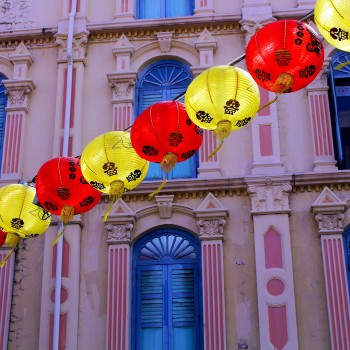
Chinese New Year
Date: February
The Chinese New Year, also referred to as the Spring Festival or the Lunar New Year, is one of the most important festivals celebrated in Singapore. It falls on the first day of the first month of the traditional lunisolar Chinese calendar and is a time of festivity.
The first day of Chinese New Year is of great significance to the Chinese who clean their homes to get rid of the bad or the ill fortune and make way for good luck. This grand festival in Singapore continues for 14 days, starting on the eve of New Year's. During this time, the Chinese locals visit their families and decorate their homes with red and gold colors.

Vesak Day
Date: April-May
Vesak Day is a religious festival celebrated by Buddhists worldwide, which falls from April-May every year. The most important day in the Buddhist calendar, the Buddhists in Singapore and worldwide celebrate this day as the birth, enlightenment, and passing of the Buddha.
Also known as Buddha Purnima, this festival enumerates the message of the Buddha and aims to remind devotees of their sacred duties of peace and tolerance.

Pongal
Date: January
Pongal is four days festival, which is celebrated widely in Southern India. In Singapore, Pongal is celebrated on the commencement of the auspicious month of Thai. On the first day, Bhogi Pongal, celebrations begin with the worship of Lord Indra, the Ruler of Clouds and Giver of Rains.
During Pongal, Little India is lit up with various events and competitions. People also exchanged gifts and wore new clothes during this festival in Singapore.

Thaipusam
Date: January
The Tamil community of Singapore celebrates the Thaipusam festival that falls on the full moon day during the Tamil month of Thai. It is a two-day festival dedicated to Lord Murugan - the Hindu God of war epitomizes youth, power, and virtue. Celebration of Thaipusam in Singapore involves early morning prayers, asceticism, self-control, processions, and piercings.
The unique feature of Thaipusam in Singapore is the huge adorned kavadi, which is carried by the devotees and involves a lot of skin piercings. Women and children also actively participate in the celebration by carrying large pots of milk to offer to God to thank him for fulfilling their dreams and desires.

Lantern Festival
Date: Last week of February
Lantern Festival or the spring lantern festival is one of the most famous festivals in Singapore. It marks the last day of celebration of the Chinese New Year. The kids carry paper lanterns outside, light them up, and release them into the sky during this day. Some paper lanterns are traditional and straightforward, whereas some are different shapes and sizes. It's a beautiful sight to see several lanterns light up the night sky.
.jpg)
Dragon Boat Festival
Date: June
The Dragon Boat Festival, also known as Duanwu Festival or the Zhongxao Festival, is a cultural festival that originates in Southern China introduced thousands of years ago. The festival is also called the Double Fifth Festival, as it falls on the fifth day of the fifth month of the Chinese calendar. The festivities include boat races and eating rice dumplings. The festival had evolved from the practice of revering the river dragon to the commemoration of Qu Yuan, a third-century poet and political figure of the state of the Chu in ancient China

National Day of Singapore
Date: 9th August
The National Day of Singapore celebrated annually on August 9, celebrates Singapore's freedom from Malaysia in 1965. The festivities begin with a National Day Parade and end with dazzling fireworks. Held at the Marina Bay, National Day celebrations include an address by the Prime Minister, followed by a spectacular fireworks show.
Attractions / Top Sights
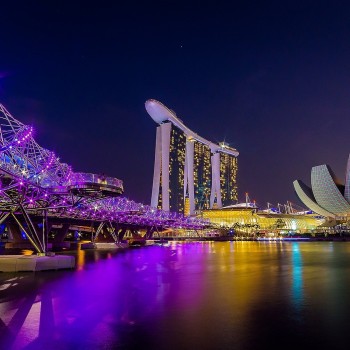
Marina Bay Sands
When to visit: February and April
When to visit: https://www.marinabaysands.com/
The famous Marina Bay Sands resort complex includes a high-end luxury hotel, upscale shopping mall, casino, the ArtScience Museum, exclusive infinity pool in the clouds with a legendary view, and the Marina Bay Sands Skypark Observation Deck–a vantage point for taking in the entire city.
Shopaholics will surely rejoice in the unlimited rows of luxury shops at The Shoppes. It has one of the most extensive collections of luxury and premium fashion, accessories, and jewelry brands globally.

Gardens by The Bay
When to visit: Between February and April
When to visit: https://www.gardensbythebay.com.sg/en.html
Gardens by The Bay is one of the most popular Singapore attractions because of its supertree structures with a fantastic skywalk; Gardens by The Bay offers hundreds of plants and trees to explore, creating a greener world in the city’s landscape.
It is commonly used as the background of music videos and films. Highlight attractions Garden by The Bay includes OCBC Skyway, Heritage Gardens, Cloud Forest, Children’s Garden, Bay East Garden, Supertree Grove, and Cloud Forest.

Orchard Road
When to visit: Between December and early March
When to visit: https://www.orchardroad.org/business?p=who-are-we
Orchard Road Business Association (ORBA) was formed in 1998 under the auspices of the Singapore Tourism Board (STB). The 2km stretch of Orchard Road lies high-end stores, Boutiques, designer stores, entertainment spots, opulent hotels, cafes, distinctive restaurants, and many more make it one of the most popular shopping streets in Singapore.
With almost 30 malls to choose from, the Orchard Road area is an excellent place to start a shopping spree, be it luxury shopping or budget shopping. It promises to satisfy all ladies’ fashion needs and leave you a wonderful shopping experience.

Botanic Garden
When to visit: Between December and early March
When to visit: https://www.nparks.gov.sg/sbg
Founded in 1859, the 82-hectare Gardens holds a unique and meaningful place in the history of Singapore and the region. The Gardens was inscribed as a UNESCO World Heritage Site at the 39th session of the World Heritage Committee (WHC) on 4 July 2015. The Gardens is the first and only tropical botanic garden on the UNESCO’s World Heritage List.
The Botanic Garden is one of the locals’ favorite recreation spots for leisure, jogging, or dining. Kids are always joyous at their Jacob Balls Children’s garden, an educational place with a maze, treehouse, and mini-garden to learn about biology and plants.

Sentosa Island
When to visit: Between December and early March
When to visit: https://www.sentosa.com.sg/en
Sentosa Island in Singapore, popularly known as The State of Fun, is Asia's leading leisure destination and Singapore's premier island resort getaway, situated within 15 minutes from the central business and shopping districts.
The 500-hectare island resort is home to an astonishing array of themed attractions, spa retreats, verdant rainforests, golden sandy beaches, resort accommodations, world-renowned golf courses, a deep-water yachting marina, and luxurious residences – making Sentosa a lively island resort for business and leisure.

Universal Studio Singapore (USS)
When to visit: Between December and early March
Universal Studio Singapore (USS), the first Hollywood movie theme park in Southeast Asia, offers a fabulous selection of adrenaline-pumping rides and thrilling Singapore tourist attractions for thrill-seekers and families. Universal Studios Singapore occupies 49 acres of Resorts World Sentosa.
The park is arranged thematically, with each area paying tribute to a location, film, or television show. Destinations include New York City, Hollywood, Madagascar, and a trip back to Ancient Egypt. Fiction-themed areas include Shrek's Far Far Away, Lost World, and Sci-Fi City, where Battlestar Galactica-themed dueling roller coasters and a dark indoor coaster, Revenge of the Mummy, dominate the thrill rides.

Clarke Quay
When to visit: Between December and early March
A historical riverside quay in Singapore-Clarke Quay has served as the "center of commerce since the 19th century" and continues its legacy as a busy hub in Singapore. Clarke Quay is a refreshing place that hustles and bustles both day and night.
The Quay's hit with younger tourists is an exhilarating giant bungee-jumping attraction. Furthermore, Clarke Quay offers Singapore's most exciting nightlife scenes, as well as a handful of excellent restaurants good for dining by the historical riverside, any time of day.

Singapore Zoo
When to visit: https://www.mandai.com/en/singapore-zoo.html
The Singapore Zoo is home to extraordinary wildlife located on the north-western side of the island. The zoo was built at the cost of $9 million granted by the government of Singapore and opened on 27 June 1973, and since then, it has become one of the best rainforest zoos in the world.
Besides being home to over 2,800 animals from 300 species—including crocodiles, Malayan tapirs, and white tigers—the zoo has won international and local awards. These include plaudits from Forbes Traveler as one of the best zoos globally, the Asian Attraction Awards for Most Popular Attraction in the Wildlife Park category, and the STB 22nd Tourism Award for Best Leisure Attraction Experience Year.

Chinatown
When to visit: January to March
Chinatown is located mainly in the Outram area in the Central Region of Singapore. This ancient Chinatown is home to myriad different cultures and is the only Chinatown in the world to boast a Buddhist temple, a mosque, and a Hindu temple along a single street.
Buddha Tooth Relic Temple & Museum, found in the heart of Chinatown, a noble place of worship, is a treasury of Buddhist wisdom and relics and home to an artifact of religious reverence. The temple’s interior is architecturally designed in a mandala, a central Buddhist and Hindu concept representing a universal connection.

Raffles Hotel
When to visit: Between December and early March
Raffles Hotel colonial building is one of the world's last grand 19th-century hotels, once visited by literary noble such as Rudyard Kipling and Joseph Conrad and movie star Charlie Chaplin.
Raffles Hotel was established in 1887; the property has served as a city landmark of Singapore. The classical architecture and tropical gardens provide a refined setting and represent another facet of Singapore's varied and rich history.

















